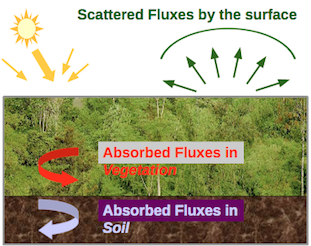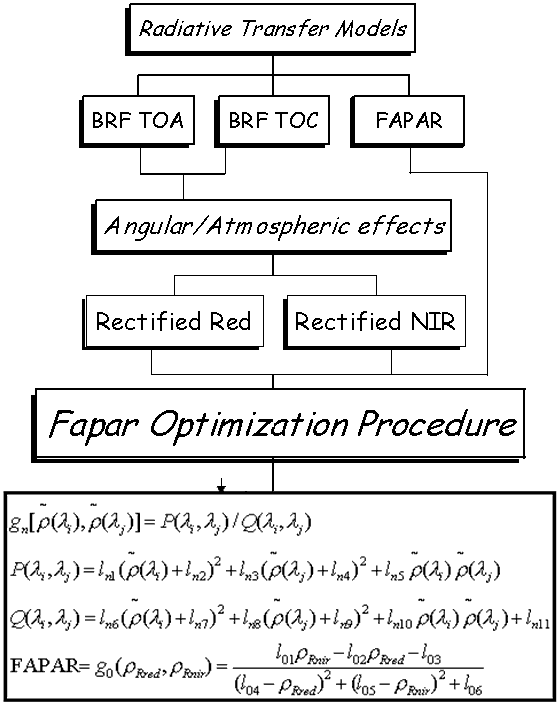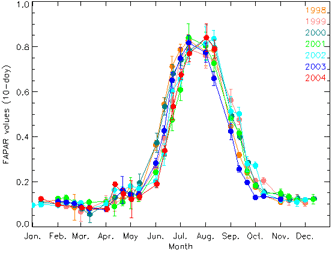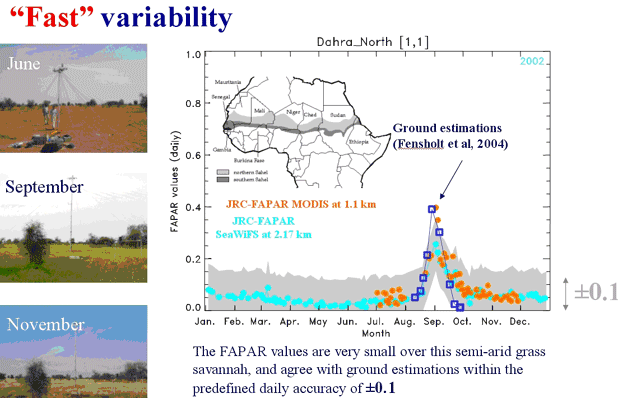
The JRC Two-Stream (JRC-TIP) derived products are delivered in the form of probability density functions (PDFs) that optimize the two-stream model parameters [Pinty et al., 2006] against the observed MODIS albedos while limiting their deviations from prior values.
The inversion scheme implemented in the JRC-TIP enables the propagation of uncertainties from the observations to the model parameters and generates a covariance matrix associated with the retrievals [Voßbeck et al., 2010]
Radiation transfer schemes suitable for GCMs must meet numerous constraints including computer efficiency and robustness, they must use measurable or retrievable variables or parameters and provide sufficiently accurate estimations of the radiant fluxes. For all practical purposes, it is enough to establish appropriate sets of equations permitting us to estimate jointly two only out of the three fluxes which are either reflected, transmitted or absorbed. Indeed at low spatial resolutions, which are more likely to satisfy the conditions imposed by a "radiatively independent volume" [Pinty et al., 2004], these three fluxes are linked by the conservation law, i.e., they sum up to 1 over a black background, independent of the canopy structure prevailing inside and outside the domain.
Radiation schemes should therefore be able to simulate accurately both the flux reflected from the top of the
canopy, that is its albedo, and the flux transmitted to the
background underneath the vegetation layer in order to
estimate the fractions of radiation absorbed separately by
the vegetation canopy and the underlying surface.
It is
noteworthy that these flux estimates have to fully account
for the lower boundary contribution, i.e., the background, so
that challenging conditions corresponding for instance to
snow surfaces can be addressed as well.
In this modeling context, the albedo and the fraction of absorbed radiation are key quantities since they affect the climate system and both can be derived reliably at the appropriate spatial and temporal resolutions from measurements gathered by the recent satellites operating in the solar domain. These two quantities are thus prime candidates for upcoming or ongoing validation and assimilation exercises.

The evaluation of the JRC-TIP products was done over the deciduous forest site of Hainich (Germany) where multiannual datasets of in-situ estimates of canopy transmission—derived from LAI-2000 observations—were available and the results can be found here:
Additional results of benchmark of the JRC-TIP against ground-based data and third-party data are available in:
More recently, the physical consistency of JRC-TIP products were also assessed in:
A generic approach to rationalize the design of optimized algorithms has been described in [Verstraete and Pinty (1996)]. Exploiting the physics of the signal and radiative transfer models, new optimized algorithms for monitoring land surfaces have been developed for various sensors ( [Gobron et al. 2000], [2001], [2002a], [2002b]).
The design of these algorithms is based on the following requirements:
They should exhibit a maximum sensitivity to the presence, and changes in the properties of healthy live green vegetation.
They should not be sensitive to atmospheric scattering and absorption effects, to soil color and brightness changes, and to temporal and spatial variations in the geometry of illumination and observation.
The algorithms must also be equivalent to each other in the sense of yielding the same bio-geophysical information when they are applied to their respective data. These constraints imply that the land products should summarize the status of a given terrestrial system with a single number whose value must, by necessity, reflect only broad characteristics of the terrestrial ecosystems and their main changes. The state and evolution of terrestrial ecosystems are characterized by a large number of physical, biochemical and physiological variables.
The estimation of a state variable from the signals measured by a given sensor is constructed from sensor-specific simulated data sets, representative of various land surfaces, using radiative transfer models of the coupled surface atmosphere system.

This approach defines a large number of simulated radiance fields, which can be sampled by a virtual instrument similar to the actual one in terms of the spectral and angular observing schemes. Similarly, the corresponding FAPAR values for the various terrestrial systems under investigation can be simultaneously estimated.
The simulations of FAPAR values have been made by assuming that the spectral properties of leaves and soil correspond to the Photosynthesis Active Radiation (PAR) region which is between 400 nm and 700 nm. In this case, simulations are made with a homogeneous canopy model ([Gobron et al. 1997]) representing land surfaces, coupled with the atmospheric model 6S (Second Simulation of the Satellite Signal in the Solar Spectrum) ( [Vermote et al. 1997]).
Since green vegetation strongly absorbs solar radiation in the red spectral region, and strongly scatters it in the near infrared, these two bands are the main ones used to characterize land surfaces from remote sensing data. The reflectance in the blue band is sensitive to the aerosols' optical thickness and, therefore, is used to decontaminate the red and the near-infrared bands from atmospheric effects.
The design of the FAPAR algorithm is based on a two steps procedure where the spectral radiances measured in the red and near-infrared bands are, first, rectified in order to ensure their decontamination from atmospheric and angular effects and, second, combined together in a mathematical formulae to generate the FAPAR value. The top of atmosphere (TOA) channel values are first normalized by the anisotropy function to take into account the angular effects
where
The spectral anisotropy reflectance function,
The rectification process of the red and near-infrared bands is performed as follows:
where
The polynomial coefficients ln,m have been optimized in such a way that the values generated by each spectral polynomial
The FAPAR itself is then computed on the basis of these rectified channel values, and its formula is:
where the coefficients
Once the coefficients are optimized for a specific sensor, then the inputs of the algorithm are the bidirectional reflectance factors values in the blue, red and near-infrared bands and the view and illumination angles values.
The validation and the performance of the JRC-products and algorithmns are evaluated with respect to further applications. [Gobron et al. 2006a] and [Gobron et al. 2006b] present the evaluation for different canopy radiation transfer regimes using the current FAPAR products derived from SeaWiFS against ground-based estimations.
The analyses of the performance of the consistency of products during a long time series were conducted over three types of vegetation using 6 years of data. These illustrate the signal variability due to the vegetation seasonal cycles as well as the signatures resulting from the occurrence of environmental stress, i.e., drought and fire events.



The FAPAR time series from 1998 to 2004 indicate very similar phenological cycles over the various years as expected for such agricultural fields in which water availability is essentially controlled by irrigation. Rice grows from April onward and reaches maturity in July/August associated with series of maxima in the FAPAR values. From September onward, harvesting is accompanied by a sharp decrease in FAPAR . The strong seasonal cycles are quite similar during these 6 years although, owing to an earlier growth in spring 2003, the FAPAR values are exhibiting an earlier decrease in 2003 as compared to other years. This example thus shows that the SeaWiFS FAPAR products are capable of monitoring well-defined seasonal cycles in a quite reproducible manner.
Two different examples are also presented in [Gobron et al. 2006a] and [Gobron et al. 2006b].
The comparison exercises between FAPAR products derived by various instruments using their specific algorithms have been made and the results summarized in [Gobron et al. (2006a)].
To our knowledge, there is no complete data set that permits addressing all the needed vertical and horizontal fluxes separately for the direct and diffuse radiation, measured with the appropriate sampling step and at a spatial resolution compatible with the JRC products, for the same ambient conditions as those prevailing during the acquisition of the remote sensing data. An extremely complex set of measurements may not be needed if we are to validate the SeaWiFS FAPAR JRC products within a ±0.1 uncertainty level. Indeed, we have shown that on the basis of model simulations of realistic vegetation canopy scenarios, the compensation between different contributions is such that approximating FAPAR by Fraction of Intercepted Active radiation (FIPA) constitutes a first good step in the comparison process.
In the JGR paper [Davis and Marshak (2004)]
Ground-based estimations are categorized with respect to their anticipated radiation transfer regime to better understand sources of uncertainties. Three types of radiative transfer regime have been defined with respect to the 3-D variability of the extinction coefficient.
[Gobron et al. 2006b], we rely only on a limited number of proxy data sets that are available, excluding high-latitude sites for which too few reliable SeaWiFS FAPAR JRC products are available owing to the occurrence of both large Sun zenith angle (larger than assigned in the algorithm training data set) and subpixel snow, water and cloud contamination. Those selected here include either measurements of local and domain-averaged gap fractions and LAI, or combinations of these measurements, and span a wide range of vegetation canopy types which therefore can also be roughly categorized according to their expected or most probable radiation transfer regimes (as deduced from the analysis carried out by
| RT Regime | Theory | Vegetation Type |
|---|---|---|
| Regime 1: "Fast" variability |
1-D RT theory on full domain | short and homogeneous vegetation over 1-2 km |
| Regime 2: "Slow" variability |
1-D RT theory locally and Independent Pixel Approximation (IPA) on full domain | mixed vegetation with different land cover types |
| Regime 3: "Resonant" variability |
3-D RT theory | intermediate height and low-density vegetation |

Comparisons against ground-based of the two other regimes are presented in [Gobron et al. 2006b].
They include other ground-based datasets over
Dahra and Tessekre sites, Senegal
Braschaat